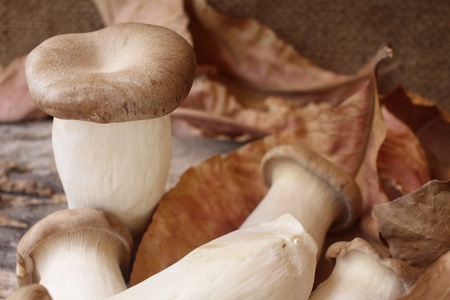
Pleurotus eryngii, also known as the king oyster mushroom or cardoncello, is gaining considerable popularity amongst consumers worldwide (Rodriguez Estrada and Royse 2007). It is a good source of dietary fiber, including β-glucans, and consists of various antioxidative compounds such as polyphenols, polysaccharides, lipids, peptides, and sterols (Fu et al., 2002; Ngai and Ng 2006; Ferreira et al., 2009). Recently, Pleurotus species have been reported to be of potential therapeutic value, based on their antioxidant, antitumor, and immunomodulatory activities (Caglarlrmak, 2007; Mori et al., 2008; Ferreira et al., 2010).
References
Caglarlrmak, N. (2007) The nutrients of exotic mushrooms (Lentinula edodes and Pleurotus species) and an estimated approach to the volatile compounds. Food Chem. 105 pp. 1188–94
Ferreira, I.C., Vaz, J.A., Vasconcelos, M.H., Martins, A. (2010) Compounds from wild mushrooms with antitumor potential. Anticancer Agents Med. Chem. 10 pp. 424–36
Fu, H.Y., Shiel, D.E., Ho, C.T. (2002) Antioxidant and free radical scavenging activities of edible mushrooms. J. Food Lipids 9 pp. 35–43
Mori, K., Kobayashi, C., Tomita, T., Inatomi, S., Ikeda, M. (2008) Antiatherosclerotic effect of the edible mushrooms Pleurotus eryngii (Eringi), Grifola frondosa (Maitake), and Hypsizygus marmoreus (Bunashimeji) in apolipoprotein E–deficient mice. Nutr. Res. 28 pp. 335–42.
Ngai, P.H., Ng, T.B. (2006) A hemolysin from the mushroom Pleurotus eryngii. Appl. Microbiol. Biotechnol. 72 pp. 1185–91.
Rodriguez Estrada, A.E., Royse, D.J. (2007) Yield, size and bacterial blotch resistance of Pleurotus eryngii grown on cottonseed hulls/oak sawdust supplemented with manganese, copper and whole ground soybean. Bioresour. Technol. 98 pp. 1898–906.
Leave a Reply